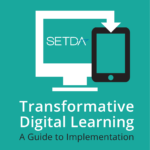
Digital learning is no longer a specialty area. Increasingly, leaders across state and district agencies in a variety of roles have shifted towards the use of technology as a primary tool for teaching and learning. Consequently, districts are moving away from technology planning as a stand-alone activity in favor of more comprehensive planning efforts that include technology tools and resources as one overarching component of achieving school-wide goals. In this integrated approach, districts carefully analyze all applications of technology across the entire school before making investments in devices, infrastructure, digital learning resources or professional development.
Comprehensive planning requires a collaborative leadership approach that starts with developing a shared vision on how digital learning tools and resources support learning; seeking input from a variety of internal and external stakeholders; communicating with all stakeholders to encourage buy-in; and using and understanding research and data to support plan goals and objectives. Other key areas to consider in the planning process include operational considerations, including budget, procurement, interoperability; student data privacy; infrastructure needs, including devices and connectivity; as well as professional development.
 Digital learning is no longer a specialty area. Increasingly, leaders across state and district agencies in a variety of roles have shifted towards the use of technology as a primary tool for teaching and learning. Consequently, districts are moving away from technology planning as a stand-alone activity in favor of more comprehensive planning efforts that include technology tools and resources as one overarching component of achieving school-wide goals. In this integrated approach, districts carefully analyze all applications of technology across the entire school before making investments in devices, infrastructure, digital learning resources or professional development.
Comprehensive planning requires a collaborative leadership approach that starts with developing a shared vision on how digital learning tools and resources support learning; seeking input from a variety of internal and external stakeholders; communicating with all stakeholders to encourage buy-in; and using and understanding research and data to support plan goals and objectives. Other key areas to consider in the planning process include operational considerations, including budget, procurement, interoperability; student data privacy; infrastructure needs, including devices and connectivity; as well as professional development.
Digital learning is no longer a specialty area. Increasingly, leaders across state and district agencies in a variety of roles have shifted towards the use of technology as a primary tool for teaching and learning. Consequently, districts are moving away from technology planning as a stand-alone activity in favor of more comprehensive planning efforts that include technology tools and resources as one overarching component of achieving school-wide goals. In this integrated approach, districts carefully analyze all applications of technology across the entire school before making investments in devices, infrastructure, digital learning resources or professional development.
Comprehensive planning requires a collaborative leadership approach that starts with developing a shared vision on how digital learning tools and resources support learning; seeking input from a variety of internal and external stakeholders; communicating with all stakeholders to encourage buy-in; and using and understanding research and data to support plan goals and objectives. Other key areas to consider in the planning process include operational considerations, including budget, procurement, interoperability; student data privacy; infrastructure needs, including devices and connectivity; as well as professional development.

